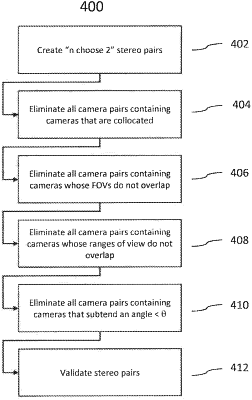| CPC G06V 20/52 (2022.01) [G06T 7/246 (2017.01); G06T 7/593 (2017.01); H04N 7/181 (2013.01); H04N 13/239 (2018.05); H04N 23/45 (2023.01); H04N 23/90 (2023.01); G06T 2207/30232 (2013.01); G06T 2207/30241 (2013.01)] | 20 Claims |

|
1. A computer-implemented method for tracking an object of interest, comprising:
detecting the object of interest across a set threshold number of frames of a first continuous video stream from a first camera of a valid stereo pair of cameras and a second continuous video stream from a second camera of the valid stereo pair of cameras, wherein the first camera and the second camera are at different physical locations, a portion of a surveillance coverage of the first camera overlaps with a portion of a surveillance coverage of the second camera, a functional range of view of the first camera overlaps with a functional range of view of the second camera, and a principal ray of the first camera and a principal ray of the second camera subtend at an angle that satisfies a threshold angle;
in response to detecting the object of interest across the set threshold number of frames of each continuous video stream, calculating a geolocation of the object of interest by comparing a 2D location of the object of interest in a frame from the first camera of the valid stereo pair of cameras to a 2D location of the object of interest in another frame from the second camera of the valid stereo pair of cameras; and
tracking the geolocation of the object of interest.
|